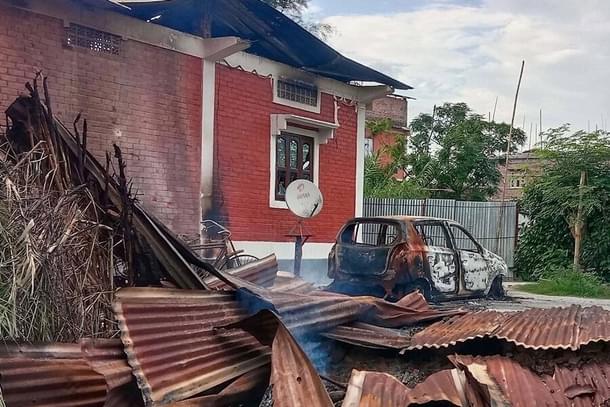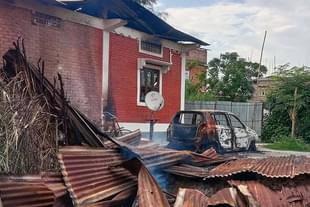Politics
The Silent Agony Of The Meiteis
Ningthem Oinam
Jun 18, 2023, 12:40 PM | Updated 12:39 PM IST
Save & read from anywhere!
Bookmark stories for easy access on any device or the Swarajya app.


The mayhem that broke out on 3 May has left many of the people in Manipur haunted, leaving a scar that would take years to heal.
In response the union government has set up a Peace Committee headed by Governor Anusuiya Uikey, judicial probe under former chief justice of Gauhati High Court and CBI investigations to facilitate the peace process in the violence torn state of Manipur.
As part of this process, dialogue will ensue and it is imperative for the Peace Committee to approach the crisis without prejudices, avoiding a tunnel visioned perspective.
As the crisis involves two communities: Meiteis, who are predominantly Hindus and the Kukis, who are mostly Christians, deliberations have already begun among the intelligentsia community.
The Meiteis constitute the largest share in the demographics. It is, however, inaccurate to approach Meiteis as a majority group. Meitei Hindus account for 42 per cent of the population, and when non-Hindu Meiteis are included, the total Meitei population amounts to roughly around 53 percent.
However, if we closely examine the total population of Manipur, which is around 28 lakh, the Meitei population of around 14.84 lakh is relatively minuscule in the Indian context. The Kukis and Nagas have a smaller share in the demographics, but they still hold substantial proportions.
These numbers have been deliberately exploited to shape a narrative and fuel divisive politics that serves the interests of forces involved in narco-terrorism.
It is pertinent to note that mainstream media, from the very beginning, has falsely portrayed the situation through a tunnel vision, a biased narration depicting the Meiteis as an aggressor attempting to drive out the Kukis.
Exploiting the larger numerical of the Meitei population, the Kuki intelligentsia appeared to have manipulated the narrative surrounding the violence by disseminating incomplete information.
Portrayal of a majority community as a perpetrator trying to cleanse out a minority community is not far-fetched in India. A lot of academicians and intellectuals thrive on such narrations, exacerbating the issue, which is problematic. The approach discredits the sufferings of the Meiteis since the onset of the violence.
In a situation where both the communities are suffering, deliberately portraying one community as the aggressors while discrediting their sufferings is highly inappropriate.
Meiteis have been screaming about their sufferings, recounting their ordeals in relief camps, the pain of losing loved ones, and the destruction of their livelihood. However, their voices have been largely ignored.
Deliberate portrayal of Meiteis as the one who initiated the violence, labelling them as ‘aggressor; has silenced their right to speak about their own sufferings. But are these portrayals true in any sense? No, they are not.
The mainstream media’s fixation on the idea that a majority community will always be the aggressor and minority community the victim, has caused them to overlook the nuances of ethnic relations in Manipur. If presented with two equally plausible narratives, they tend to be prejudiced against the majority community.
According to the report published in India Today on 2 June, around 1,988 houses belonging to Meiteis, 1,425 Kuki homes, 17 temples and 221 churches were destroyed or burned down.
More properties have been destroyed since the report was published. These figures reveal that violence was not led by the majority community, as most of the houses that were burned down or destroyed belonged to the Meitei community. The position maintained by the Kuki intelligentsia and certain liberal intellectuals appears to be erroneous.
On the contrary, Kuki militants, including both SoO (Suspension of Operations) and Non-SoO cadres, as well as forces from Myanmar have been targeting Meitei villages since the beginning of the violence. These militant groups, often in the pretext of protecting their villages, have used sophisticated arms to inflict terror on Meitei villages.
The Meitei mobs in desperation to defend their villages from these armed and trained militants, resorted to looting arms from the police.
Unfortunately, mainstream media has exploited these circumstances, labelling the Meitei civilians and cultural organisations like Arambai Tenggol as militant groups. However, these organisations primarily focus on youth-based activities and development of Manipur’s culture. Members of such cultural organisations do not receive training for sophisticated weapons unlike the Kuki militants who specialise in warfare tactics and combat strategies using sophisticated weapons.
Therefore, it cannot be portrayed as a clash between villagers and armed militants. The two cannot be on par, one is a civilian, the other is a secessionist terror outfit. It is clearly a terror attack on Meitei civilians by Kuki militants, including forces from across the porous border. If there is any one-sided violence, it is the large-scale terror unleashed by the Kuki militants.
The deliberate terror targeting the Meitei community has intensified existing concerns about the impending threat to the Meitei identity.
Prior to the violence, Meiteis were anxious about their slow population growth and changing demographics resulting from the migration of several Kuki tribes over the past century. While Meiteis had access to only 10 per cent of the total land in Manipur, the remaining 90 per cent, referred to as hill areas, were primarily available to other tribes such as the Kukis and Nagas.
However, it is important to note that this 10 per cent accessible to the Meiteis were also accessible to all tribes and others. So, the actual land area available to Meiteis is much less than the reported 10 per cent. Seeing this as a threat to the Meitei identity, it has spread fear among the Meiteis.
The Meitei community strongly feels that, relatively, little effort has been made to protect their identity and address their aspirations. Due to the sheer number of the Meiteis and their culture, they have always been undermined and their aspirations ignored.
Meiteis have lived with the label of ‘ruling class’ or the ‘ruling community’, terms constructed to fuel divisive politics often launched by tribal representatives, creating a dichotomy of ‘valley and hill’ or ‘tribal and non-tribal’ to serve their electoral agendas and appeal the public.
However, these divisions are baseless. Historically, Meiteis were considered as tribals by the British and contrary to the claims made by tribal intellectuals, the Meiteis are not as developed and advanced as portrayed.
All communities have their stakes in the social, political and economic landscape of the state. The presence of more assembly seats in the valley does not imply that other tribal communities are under-represented. The number of seats represented people’s share in the population.
In fact, Manipur has had two Naga chief ministers, including Rishang Keishing, one of the longest serving chief ministers after Ibobi Singh. Besides, there are six Autonomous District Councils instituted under the state legislation to protect the aspirations of the hill tribes.
According to a press conference held by the Director of Tribal Affairs and Hills Development Department, the budget allocations in the hill districts have also substantially increased and in the fiscal year 2020-21 the budget allocation for development reached approximately 46 per cent for hill districts.
All these factors were already causing anxiety among the Meiteis but the outbreak of violence and targeting of Meiteis, pushed them off the edge. Moreover, they were unfairly labelled as aggressors, their stories discredited, and their voices were disregarded. The mainstream media made little effort to represent the voices of the Meitei community.
Although violence is never justified, the fears and anxieties of the Meitei community are rational. For peace to ensue, it is indispensable to ensure that the Meiteis are provided a sense of security and that their aspirations addressed accordingly.




